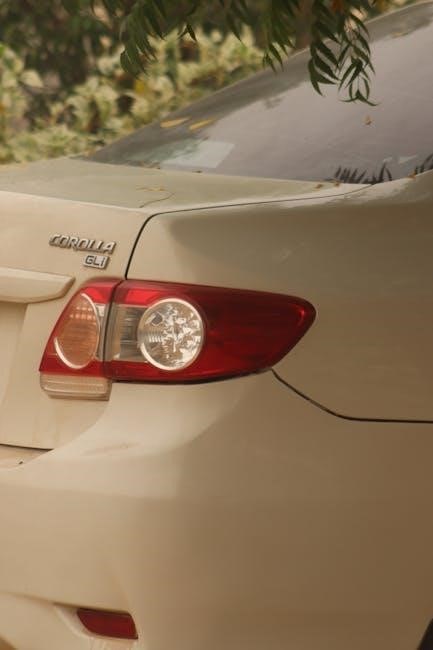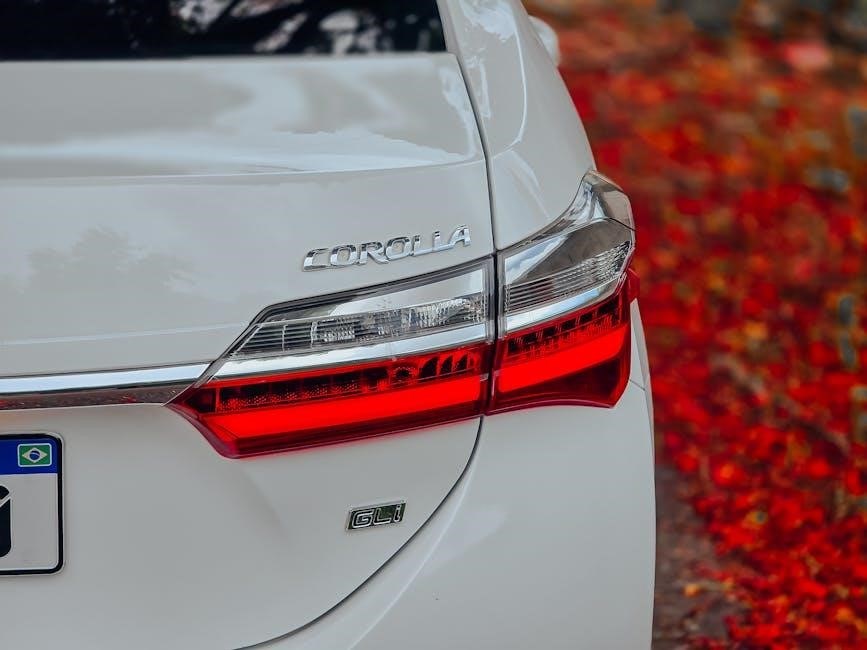Welcome to the Toyota Corolla 2012 Owners Manual, your comprehensive guide to understanding and maintaining your vehicle. This manual provides essential information on features, operation, and maintenance to ensure safe and enjoyable driving experiences. It serves as a valuable resource for maximizing your vehicle’s performance and longevity.

Key Features of the 2012 Toyota Corolla
The 2012 Toyota Corolla offers a range of features, including efficient engine options, comfortable seating, and advanced technology. It provides a balance of reliability, fuel efficiency, and affordability, making it a practical choice for daily driving.
Engine Specifications
The 2012 Toyota Corolla is equipped with a fuel-efficient 1.8-liter 4-cylinder engine, delivering 132 horsepower and 128 lb-ft of torque. This engine is paired with a choice of 5-speed manual or 4-speed automatic transmissions. Designed for optimal performance, it achieves an EPA-estimated 27 MPG city and 34 MPG highway, making it an excellent choice for commuters. The engine features variable valve timing and electronic fuel injection, ensuring smooth power delivery and reduced emissions. It operates on regular unleaded gasoline and is built to provide long-term reliability. Proper maintenance, as outlined in the manual, ensures the engine retains its efficiency and performance over time. This powertrain combination strikes a balance between power and fuel economy, catering to everyday driving needs.
Transmission Options
The 2012 Toyota Corolla offers two transmission options to suit different driving preferences. The standard 5-speed manual transmission provides precise control and sporty handling, ideal for drivers who enjoy engaging with the vehicle. It features a smooth, responsive gear shift system and is designed to maximize fuel efficiency. For those seeking convenience, the 4-speed automatic transmission offers seamless gear transitions and ease of operation, especially in stop-and-go traffic. Both transmissions are paired with the 1.8-liter engine and are designed to deliver optimal performance and fuel economy. The manual transmission achieves an EPA-estimated 27 MPG city and 34 MPG highway, while the automatic slightly lowers highway fuel efficiency to 32 MPG. These options ensure a balance between driver engagement and practicality, catering to diverse driving needs.
Trim Levels
The 2012 Toyota Corolla is available in several trim levels, each designed to cater to different preferences and budgets. The base model offers essential features for everyday driving, including air conditioning, AM/FM/CD audio, and power windows. The LE trim adds convenience features like keyless entry, cruise control, and steering wheel audio controls. The S trim provides a sportier appeal with unique exterior styling, fog lights, and alloy wheels, while the XLE focuses on luxury with features like automatic climate control, heated seats, and a premium audio system. Each trim level ensures a comfortable and enjoyable driving experience, whether prioritizing simplicity, convenience, or style. These options allow drivers to choose the perfect balance of features to match their lifestyle and preferences.

Safety Features and Precautions
This section outlines the safety features and precautions for the 2012 Toyota Corolla, ensuring safe operation and occupant protection. It covers essential systems and guidelines to maximize safety.
SRS Airbag System
The SRS Airbag System in the 2012 Toyota Corolla is designed to enhance occupant safety during collisions. It includes front airbags for the driver and passenger, as well as side and curtain airbags for additional protection. The system deploys airbags automatically in the event of a severe impact, reducing the risk of injury. Proper use of seat belts is crucial for optimal airbag performance. The SRS system includes a warning light on the instrument cluster that illuminates during ignition and turns off after a few seconds. If the light remains on or flashes, it indicates a malfunction, and the system should be inspected by a Toyota dealer immediately. Regular maintenance, such as ensuring the airbag sensors are free from damage, is essential for reliable operation. Always follow the manufacturer’s guidelines for any modifications or repairs involving the SRS system.
Seat Belt Pretensioners
The Seat Belt Pretensioners in the 2012 Toyota Corolla are designed to enhance safety by automatically tightening the seat belts during a collision or sudden stop. This system works in conjunction with the SRS airbag system to reduce the risk of injury by ensuring occupants are securely restrained. The pretensioners activate in the event of a severe impact, pulling the seat belt tighter to minimize movement. They are a single-use component and must be replaced by a Toyota dealer after deployment. The system includes a warning light on the instrument cluster that illuminates if a malfunction is detected. Proper maintenance, such as ensuring seat belts are clean and free from damage, is essential for reliable operation. Always refer to the owner’s manual for specific instructions and guidelines for inspection and servicing.
Child Restraint System
The Child Restraint System in the 2012 Toyota Corolla is designed to ensure the safety of children while traveling. The vehicle is equipped with LATCH (Lower Anchors and Tethers for Children), providing a secure method for installing child seats without using seat belts. This system includes lower anchors located in the rear seats and tether anchors for securing the top of the child seat. The manual emphasizes the importance of properly installing child restraints to maximize safety. It also provides guidelines for selecting the appropriate seat based on the child’s weight and height. Additionally, the Corolla supports ISOFIX compatible child seats, offering flexibility for different types of restraints. Always refer to the owner’s manual for detailed instructions and ensure the system is used correctly to protect children in the event of sudden stops or collisions. Proper installation is critical for the effectiveness of the child restraint system.
Anti-lock Brake System
The Anti-lock Brake System (ABS) in the 2012 Toyota Corolla is a critical safety feature designed to prevent wheel lock-up during hard braking, ensuring optimal control and stability. ABS rapidly pumps the brakes to maintain tire traction with the road, reducing the risk of skidding and shortening stopping distances. This system is especially beneficial on slippery or uneven surfaces, where maintaining vehicle control is crucial. The ABS works in conjunction with the brake assist feature to enhance braking effectiveness. When ABS activates, drivers may feel a pulsating sensation in the brake pedal or hear a noise, which is normal and indicates the system is functioning. Proper maintenance, such as avoiding tampering with ABS components and ensuring regular brake inspections, is essential for its reliability. Always refer to the owner’s manual for specific guidance on ABS operation and care;
Vehicle Stability Control
The Vehicle Stability Control (VSC) system in the 2012 Toyota Corolla enhances driving stability by automatically adjusting engine power and braking individual wheels to help maintain the driver’s intended path. This advanced safety feature is particularly effective on slippery or uneven surfaces, where loss of traction can occur. VSC works in conjunction with systems like ABS and Traction Control to improve overall vehicle stability. When the system activates, drivers may notice a slight decrease in engine power or subtle braking on specific wheels. This system is always active and operates seamlessly in the background to provide enhanced control. Proper operation of VSC is essential for safety, and drivers should avoid deactivating it except in extreme circumstances, such as driving in deep snow. Regular maintenance of related components ensures optimal functionality. Always refer to the owner’s manual for specific guidance on VSC operation and care.
Traction Control
The Traction Control (TRAC) system in the 2012 Toyota Corolla is designed to enhance traction and stability by preventing wheel slippage during acceleration. This system automatically adjusts engine power and applies braking to individual wheels when excessive wheelspin is detected, ensuring optimal grip on various road surfaces. TRAC is particularly beneficial on slippery or uneven terrain, helping to maintain control and reduce skidding. The system operates seamlessly in the background and is always active unless manually deactivated. Drivers can deactivate TRAC using the TRAC OFF button located on the instrument panel, which may be necessary in certain conditions, such as driving in deep snow. However, turning off TRAC can reduce vehicle stability, so it should be done with caution. Regular maintenance of tires and braking systems ensures proper functionality of the TRAC system. Refer to the manual for detailed instructions and guidelines on using this feature effectively.

Maintenance and Care
Regular maintenance is crucial for the longevity and reliability of your 2012 Toyota Corolla. Follow the recommended service schedule, inspect fluids, tires, and belts, and clean the vehicle regularly to ensure optimal performance and appearance.
Routine Maintenance

Regular routine maintenance is essential to keep your 2012 Toyota Corolla running smoothly and prolong its lifespan. This includes oil changes, tire rotations, and fluid checks. Ensure to inspect brakes, belts, and battery condition during service visits. Follow the recommended schedule in your owners manual to avoid premature wear and potential repairs. Proper maintenance also enhances fuel efficiency and overall vehicle performance. Always refer to the manual for specific guidelines and intervals tailored to your vehicle’s needs. By staying consistent with routine care, you can maintain your Corolla’s reliability and ensure safe, trouble-free driving for years to come.
Recommended Service Schedule
The 2012 Toyota Corolla owners manual outlines a detailed recommended service schedule to ensure optimal vehicle performance and longevity. Regular maintenance intervals are designed to address critical components such as oil changes, tire rotations, and fluid replacements. The manual specifies that oil should be changed every 5,000 to 7,500 miles, depending on driving conditions. Additionally, tire rotations are recommended every 5,000 miles to ensure even tread wear. Brake pads and rotors should be inspected every 10,000 miles, while the timing belt is advised to be replaced at 90,000 miles. Following this schedule helps prevent costly repairs and ensures your Corolla runs efficiently. Always consult the manual for specific guidelines tailored to your driving habits and conditions.
DIY Maintenance Tips
The 2012 Toyota Corolla owners manual provides practical DIY maintenance tips to help owners keep their vehicle in top condition. Regular oil changes, tire pressure checks, and air filter inspections are essential tasks that can be performed at home. The manual recommends checking the oil level weekly and replacing it every 5,000 to 7,500 miles. Tire pressure should be monitored monthly and adjusted according to the specifications listed in the manual. Additionally, the air filter should be inspected every 15,000 miles and replaced as needed to ensure proper engine performance. For battery maintenance, owners are advised to clean terminals and check electrolyte levels periodically. These simple tasks can save time and money while maintaining the vehicle’s reliability and efficiency. Always refer to the manual for detailed instructions before starting any DIY maintenance.

Vehicle Operation
The Toyota Corolla 2012 Owners Manual provides detailed guidance on operating your vehicle safely and efficiently. It covers essential systems like the instrument cluster, smart key functionality, and door/trunk operation, ensuring a smooth driving experience.
Instrument Cluster
The instrument cluster in your Toyota Corolla 2012 is designed to provide clear and essential information at a glance. It features a speedometer, tachometer, and fuel level gauge, along with warning lights for system malfunctions. The cluster also includes indicators for the SRS airbag system, anti-lock brake system (ABS), and vehicle stability control (VSC). A multi-information display is available in certain trims, offering customizable settings to show trip data, fuel efficiency, and more. The instrument cluster is illuminated for better visibility during nighttime driving. Always refer to the owners manual for guidance on understanding and responding to warning lights and indicators to ensure safe and optimal vehicle operation. Proper monitoring of the instrument cluster helps maintain your vehicle’s performance and longevity;
Smart Key System
The Smart Key System in the Toyota Corolla 2012 offers convenient and advanced vehicle access. With the electronic key, you can unlock and start your car without physically inserting a key. The system allows for keyless entry and push-button start, enhancing ease of use. The smart key operates within a range of approximately 2.3 feet from the front doors or trunk. It also features customizable settings, such as adjusting which doors unlock upon entry. The electronic key’s battery life typically lasts 1-2 years, and replacement is straightforward. Additionally, the system includes a wireless remote control for locking, unlocking, and trunk access. For added security, the Smart Key System can be deactivated or customized through your Toyota dealer. This feature ensures a seamless and modern driving experience, combining convenience and safety.
Doors and Trunk
The Toyota Corolla 2012 features a convenient door and trunk system designed for easy access and secure closure. The smart key system allows for keyless entry, with sensors on the door handles enabling locking and unlocking with a simple touch. The trunk can be opened using the electronic key or remote control, offering hands-free access when your hands are full. The doors and trunk are equipped with advanced locking mechanisms that ensure safety and security. Additionally, the system includes features like automatic door locking upon driving away and a trunk release function for emergencies. Proper maintenance of door and trunk components, such as lubricating hinges and checking sensors, is recommended to maintain optimal functionality. This system enhances both convenience and security, providing a seamless user experience for drivers and passengers alike.
Electronic Key Battery
The Toyota Corolla 2012 smart key system relies on a battery-powered electronic key for operation. The standard battery life is approximately 1 to 2 years, even when not in frequent use, as the key continuously receives radio waves. If the smart key system or wireless remote control malfunctions, it may indicate a depleted battery. Symptoms include delayed responses or reduced detection range. To replace the battery, use a CR2032 lithium battery, ensuring it is installed correctly to avoid damage. After replacement, test the key to confirm proper functionality. Proper care, such as avoiding exposure to high temperatures, moisture, or electromagnetic fields, can extend battery life. Regular checks and timely replacements are essential to maintain the convenience and security of the smart key system.
Wireless Remote Control
The wireless remote control for the Toyota Corolla 2012 allows convenient locking and unlocking of doors and trunk from a distance. Pressing the button locks all doors, while a double press unlocks them. The trunk can also be opened using the remote. If the remote fails to function, check the battery, as depletion may occur over time. Replace the battery with a CR2032 lithium type, ensuring proper installation to avoid damage. If issues persist, consult your Toyota dealer. Customizable settings, such as trunk unlock functionality, can be adjusted through the dealer. This feature enhances security and accessibility, offering a seamless driving experience. Regular checks and maintenance ensure optimal performance of the wireless remote control system.
Customizable Features
The Toyota Corolla 2012 offers a range of customizable features to tailor your driving experience. Owners can adjust settings such as door unlock functions, trunk operation, and smart key system preferences. For instance, the trunk can be programmed to open with a double-click of the remote or set to unlock only the driver’s door initially. Additionally, the smart key system can be customized to disable the entry function or modify alarm settings. These adjustments enhance convenience and personalization, allowing owners to adapt the vehicle to their preferences. To modify these settings, consult your Toyota dealer, as some features require professional calibration. This flexibility ensures a more enjoyable and personalized ownership experience, aligning with your unique lifestyle and driving habits. Refer to the manual or contact your dealer for detailed instructions on customization options.

Driving Information
The Toyota Corolla 2012 Owners Manual provides essential driving information, including speed limits, towing guidelines, and safe driving practices. It ensures a smooth and secure driving experience while adhering to traffic regulations and vehicle capabilities. Always follow the recommended protocols for optimal performance and safety.
Towing Guidelines
For safe towing with your Toyota Corolla 2012, the owners manual recommends adhering to specific guidelines. The maximum towing speed is 65 mph (104 km/h) on flat, straight, dry roads. Always follow the lowest speed limit—whether it’s the posted towing limit, your trailer’s specified limit, or the vehicle-trailer combination. Ensure your trailer is properly secured and its weight does not exceed the vehicle’s towing capacity. Avoid sudden acceleration or braking, and use a suitable hitch and wiring harness. Regularly inspect the towing equipment and trailer brakes for optimal safety. Additionally, monitor the vehicle’s temperature gauge to prevent overheating. For detailed instructions, consult the towing section in the manual to ensure safe and efficient towing operations.
Speed Limits

Adhering to speed limits is crucial for safe driving and optimal fuel efficiency in your Toyota Corolla 2012. Always follow posted speed limits, as they are set to ensure safety under various road conditions. The owners manual emphasizes the importance of adjusting your speed according to weather, traffic, and road type. Use the speedometer on the instrument cluster to monitor your speed accurately. Avoid excessive speeding, as it can increase fuel consumption and reduce vehicle control. For towing, the maximum recommended speed is 65 mph (104 km/h) on flat, straight, dry roads. Never exceed the posted speed limit or the trailer’s specified limit. Drive responsibly to enhance safety and efficiency, and refer to the manual for additional guidance on speed-related recommendations.

Legal and Technical Information
The Toyota Corolla 2012 Owners Manual includes essential legal and technical details. It outlines compliance with regulations, emission standards, and data recording systems like the Event Data Recorder. The manual also provides information on non-genuine parts and their implications, ensuring owners understand warranty and safety responsibilities.
Emission Specifications
The 2012 Toyota Corolla is designed to meet strict emission standards set by regulatory bodies. The vehicle is equipped with advanced systems, including a catalytic converter and exhaust gas recirculation, to minimize harmful emissions. Additionally, the Corolla features a fuel evaporative emissions system that prevents fuel vapors from escaping into the atmosphere. The manual emphasizes the importance of proper maintenance to ensure optimal emission performance, such as regular checks of the emission control systems and adherence to the recommended service schedule. Owners are also advised to use the correct grade of fuel to maintain efficiency and reduce emissions. The Corolla complies with EPA standards, ensuring it operates within legal emission limits. Proper care and adherence to these guidelines help preserve the environment and maintain the vehicle’s efficiency over time.

Event Data Recorder
The 2012 Toyota Corolla is equipped with an Event Data Recorder (EDR), which records specific vehicle data during certain crash or near-crash events, such as airbag deployment or severe braking. The EDR captures information like vehicle speed, accelerator position, and seat belt usage to help understand the circumstances surrounding an incident. This data is primarily used to improve vehicle safety and performance. Importantly, Toyota will not disclose EDR data to third parties without the vehicle owner’s consent, except in response to legal requests or official investigations. The EDR does not record personal identifying information or audio/video data. For detailed information on data collection and privacy, refer to the manual’s legal disclosures section. This feature underscores Toyota’s commitment to safety and transparency, ensuring owners are informed about their vehicle’s operation and data handling practices. Routine maintenance does not affect the EDR’s functionality.
Emission Inspection and Maintenance
The 2012 Toyota Corolla is designed to meet strict emission standards, ensuring environmental compliance and performance. Regular emission inspection and maintenance are crucial to maintaining the vehicle’s efficiency and reducing its environmental impact. The manual outlines procedures for inspecting and maintaining emission-related components, such as the exhaust system and catalytic converter. Proper servicing ensures these systems function optimally, preventing potential issues and costly repairs. Owners are advised to follow the recommended maintenance schedule to keep their vehicle in compliance with local emission regulations. Neglecting these inspections can lead to system malfunctions or failure to pass mandatory emission tests. By adhering to the guidelines, owners can contribute to a cleaner environment while ensuring their Corolla operates at peak efficiency. Regular checks and timely repairs are essential for maintaining the vehicle’s performance and longevity. This section emphasizes the importance of proactive maintenance for environmental and operational benefits.